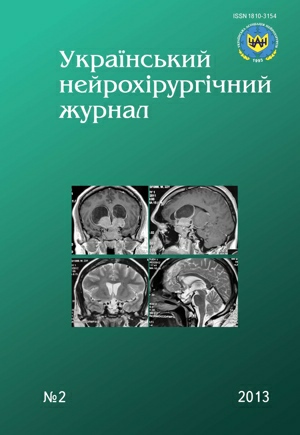Puncture surgical technology in treatment of discogenic pain syndrome of the lumbar spine
DOI:
https://doi.org/10.25305/unj.51872Keywords:
disc protrusion, laser puncture microdiscectomy, long-term intralaminar epidural pharmacotherapyAbstract
Purpose. To assess immediate and long-term outcomes of pain syndromes treatment in patients with protrusion of intervertebral discs of the lumbar spine, using differentiated techniques of puncture laser microdiscectomy (PLM) and long-term intralaminar epidural pharmacotherapy (IEP).
Materials and methods. A retrospective dynamic study of 125 patients with lumbar spine osteochondrosis, complicated by intervertebral disc protrusion, was conducted. The efficiency of pain syndromes treatment was assessed by pain syndrome intensity in the lumbar spine (PSILS) and the lower limb (PSILL) in the early (up to 3 months), intermediate (up to 6 months) and remote (after 12 months) postoperative period.
Results. The analysis of results of different methods of treatment indixated that method of long-term IEP provided fast effect: 3 months later PSILS was (2.8±0.1) points, PSILL — (3.2±0,1) points, Oswestry index — (29.0±0.6)%, but over time it decreased: 12 months later PSILS was (3.4±0.1) points, PSILL — (3.7±0.1) points, Oswestry index — (33.3±0)%. PLM provided less pronounced analgesic effect in the immediate period after surgery: 3 months later PSILS was (4.3±0.1) points, PSILL — (3.9±0.1) points, Oswestry index — (42.7±0.7)%, but over time it increased: 12 months later PSILS was (2.5±0.1) points, PSILL — (2.6±0.2) points, Oswestry index — (30.8±1.2)%.
Conclusions. The use of modern puncture surgical techniques is highly effective in treatment of pain syndromes of spinal osteochondrosis with intervertebral disc protrusion of lumbar spine.
References
1. Zozulya YA, Pedachenko EG, Slynko EI. Khirurgicheskoye lecheniye neyrokompressionnykh poyasnichno-kresttsovykh bolevykh sindromov [Surgical treatment for pain due to lumbosacral nerve root compression]. Kiev: UIPK EksOb; 2006. 348 p. Russian.
2. Khizhnyak MB, Pedachenko EG. Punktsionnaya lazernaya mikrodiskektomiya [Percutaneous laser microdiscectomy]. Kiev: Vydavnytstvo Raevskogo; 2009. 128 p. Russian.
3. Shchedrenok VV, Yakovenko IV, Anikeyev NV, Sebelev KI, Moguchaya OV. Maloinvazivnaya khirurgiya degenerativnykh zabolevaniy pozvonochnika [Minimally invasive surgery of degenerative diseases of the spine]. St. Petersburg: Polenov Neurosurgical Institute, 2011. 435 p. Russian.
4. Jeong HS, Lee JW, Kim SH, Myung JS, Kim JH, Kang HS. Effectiveness of transforaminal epidural steroid injection by using a preganglionic approach: a prospective randomized controlled study. Radiology. 2007 Nov;245(2):584-90. [PubMed] [CrossRef]
5. McGrath JM, Schaefer MP, Malkamaki DM. Incidence and characteristics of complications from epidural steroid injections. Pain Med. 2011 May;12(5):726-31. Epub 2011 Mar 10. [PubMed] [CrossRef]
6. Lee JH, An JH, Lee SH. Comparison of the effectiveness of interlaminar and bilateral transforaminal epidural steroid injections in treatment of patients with lumbosacral disc herniation and spinal stenosis. Clin J Pain. 2009 Mar-Apr;25(3):206-10. [PubMed] [CrossRef]
Downloads
Published
How to Cite
Issue
Section
License
Copyright (c) 2013 Mykhaylo Khyzhnyak, Eugenе Priymak

This work is licensed under a Creative Commons Attribution 4.0 International License.
Ukrainian Neurosurgical Journal abides by the CREATIVE COMMONS copyright rights and permissions for open access journals.
Authors, who are published in this Journal, agree to the following conditions:
1. The authors reserve the right to authorship of the work and pass the first publication right of this work to the Journal under the terms of Creative Commons Attribution License, which allows others to freely distribute the published research with the obligatory reference to the authors of the original work and the first publication of the work in this Journal.
2. The authors have the right to conclude separate supplement agreements that relate to non-exclusive work distribution in the form of which it has been published by the Journal (for example, to upload the work to the online storage of the Journal or publish it as part of a monograph), provided that the reference to the first publication of the work in this Journal is included.









